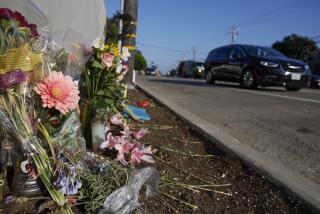After Repairs, Highway Is Still a Road to Ruin
- Share via
HIGHWAY TO THE SEA, Colombia — Six years ago, it was the most dangerous road in Colombia.
Now, after millions of dollars in repairs, the Highway to the Sea from Colombia’s main Pacific port, Buenaventura, to its third-largest city, Cali, is less hazardous--but not by much.
Imagine putting the traffic from the Harbor Freeway onto twisting Angeles Crest Highway with one-eyed ambulance drivers behind the wheel. Then throw in the threat of kidnap.
That would be a good day.
“It’s incredibly dangerous, that’s for sure,” said Fernando Rios, a taxicab driver who makes the arduous five-hour round trip on the two-lane road twice a day. “Sometimes I see two accidents a day.”
The government officially recorded only 133 crashes along the entire 70-mile stretch of road last year. But those who drive the road say most accidents aren’t reported; instead, cars are simply loaded onto tow trucks and hauled away for repair. A reporter who recently traveled on the road saw three wrecks in three days.
Besides accidents, there are also the problems of kidnapping and murder. The road travels through areas controlled by right-wing paramilitaries and the country’s two main leftist guerrilla forces.
Last year, on a stretch of the road just outside Cali, about 80 people were kidnapped by guerrillas from the leftist National Liberation Army--or ELN, for its Spanish initials--while they dined at a series of popular roadside restaurants. In a town halfway between Buenaventura and Cali, members of the Revolutionary Armed Forces of Colombia, or FARC, the country’s largest rebel group, killed four police officers in December.
Nonetheless, highway planners say they have done much to improve the road, which in 1995 had the highest number of accidents per kilometer in Colombia.
“With growing global competition, we have made investments to improve all the cargo routes,” said Gloria Cecilia Ospina, the sub-director of the national highway department. “The Buenaventura-to-Cali route is one of the most important in the country because a huge amount of the country’s goods enters and exits from there.”
But if the “Mad Max”-style road is better now, it’s difficult to picture what it must have been like before the improvements.
The Highway to the Sea ends in Buenaventura, a grimy port of 400,000 where the buildings that haven’t already collapsed seem to list precariously, locked in a battle with gravity and the oppressive coastal humidity.
The road is the only paved way into and out of the city, which is surrounded on all sides by dense jungle. As a result, most of the populace have chosen to cram onto the margins of the highway.
That means a continuous flux of schoolchildren and drunks, taxi drivers and hustlers. With few traffic lights, any bottleneck brings a swarm of vendors, who sell everything from cellular phone battery chargers to brown chunks of cocada, a local confection of coconut and sugar cane.
And while traffic engineers claim to have improved the problems in Buenaventura with stop signs and community education programs, the city’s mostly black residents say they have been ignored by the central government, located two mountain ranges and 200 miles away.
“The only thing the government cares about is the port,” said Arlington Agudelo, the local human rights representative. “Racism and slavery continue here.”
The government cares about the port in part because it provides transit for about 70% of Colombia’s imports and exports. That, in turn, means one sure menace for those driving the narrow road: huge, speeding trucks.
In fact, according to highway department statistics, nearly 86% of the vehicles on the road are tractor-trailers. It is not uncommon to see an 18-wheeler labeled “Warning! Flammable Liquid!” accelerating into oncoming lanes to pass other, slower trucks.
But that is only one end of the route, which winds slowly from the coastal jungle into the easternmost range of the Andes, 6,500 feet high, before dropping via a series of hairpin turns to the broad savanna where Cali lies.
Along the way, the road passes through one of the rainiest areas of Colombia, making constant the threat of landslides. On one recent trip, boulders the size of Volkswagens had tumbled off the high mountains onto two sections of road.
At the summit in the high Andes, a thick fog often blankets the road. There are no street lights, and drivers only occasionally feel the need to turn on their headlights.
Not to be outdone by nature, humans have added their own mix of hazards to the road.
The speed limit is posted at about 25 mph for curves. But taxicab and truck drivers, in a hurry to move more cargo for more money and unimpeded by the presence of police, routinely double that figure.
And since the road is the only transit point into and out of the region, the cars and trucks share the road with every other kind of transport: bicyclists, pedestrians, motor scooters.
Most dangerous, though, are the horses that clog the sides of the road pulling wagons filled with local produce. Skinny, bedraggled beasts, they seem completely unaware of the cars and trucks whizzing inches from them, perhaps hoping for a crash and a quick end to misery.
*
Times staff writer Miller reported from the highway and special correspondent Hoyos from Bogota.
More to Read
Sign up for Essential California
The most important California stories and recommendations in your inbox every morning.
You may occasionally receive promotional content from the Los Angeles Times.










